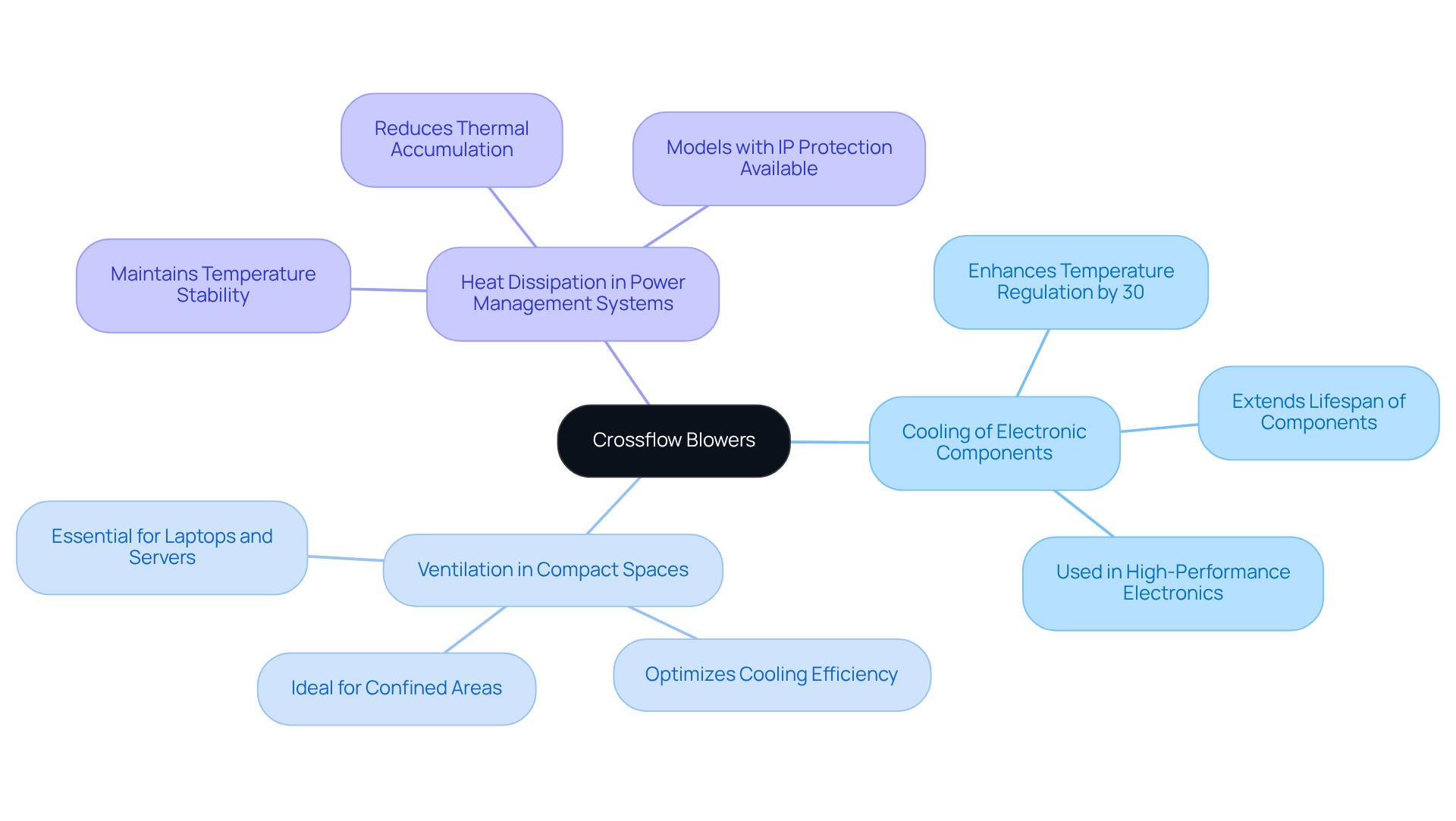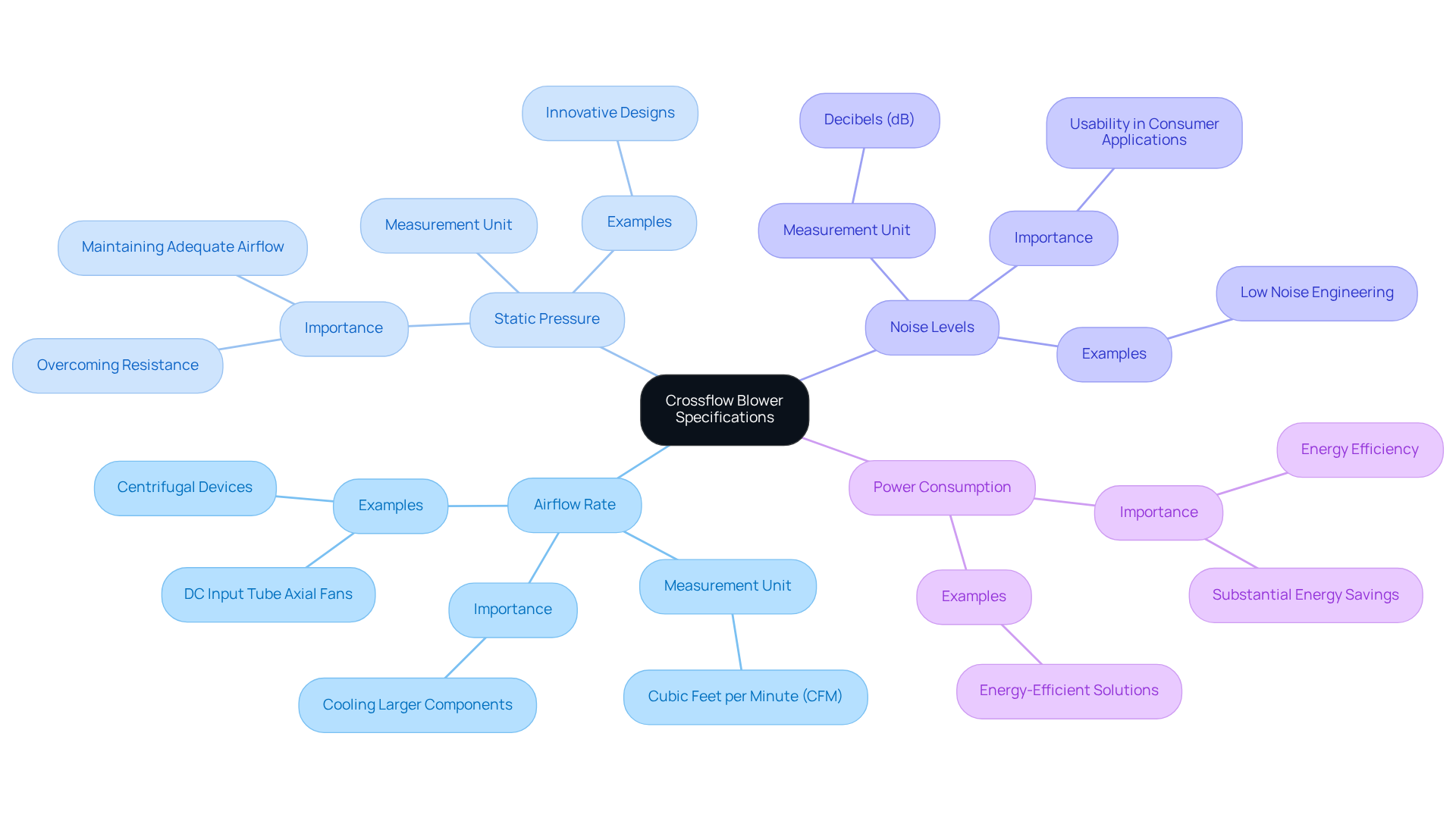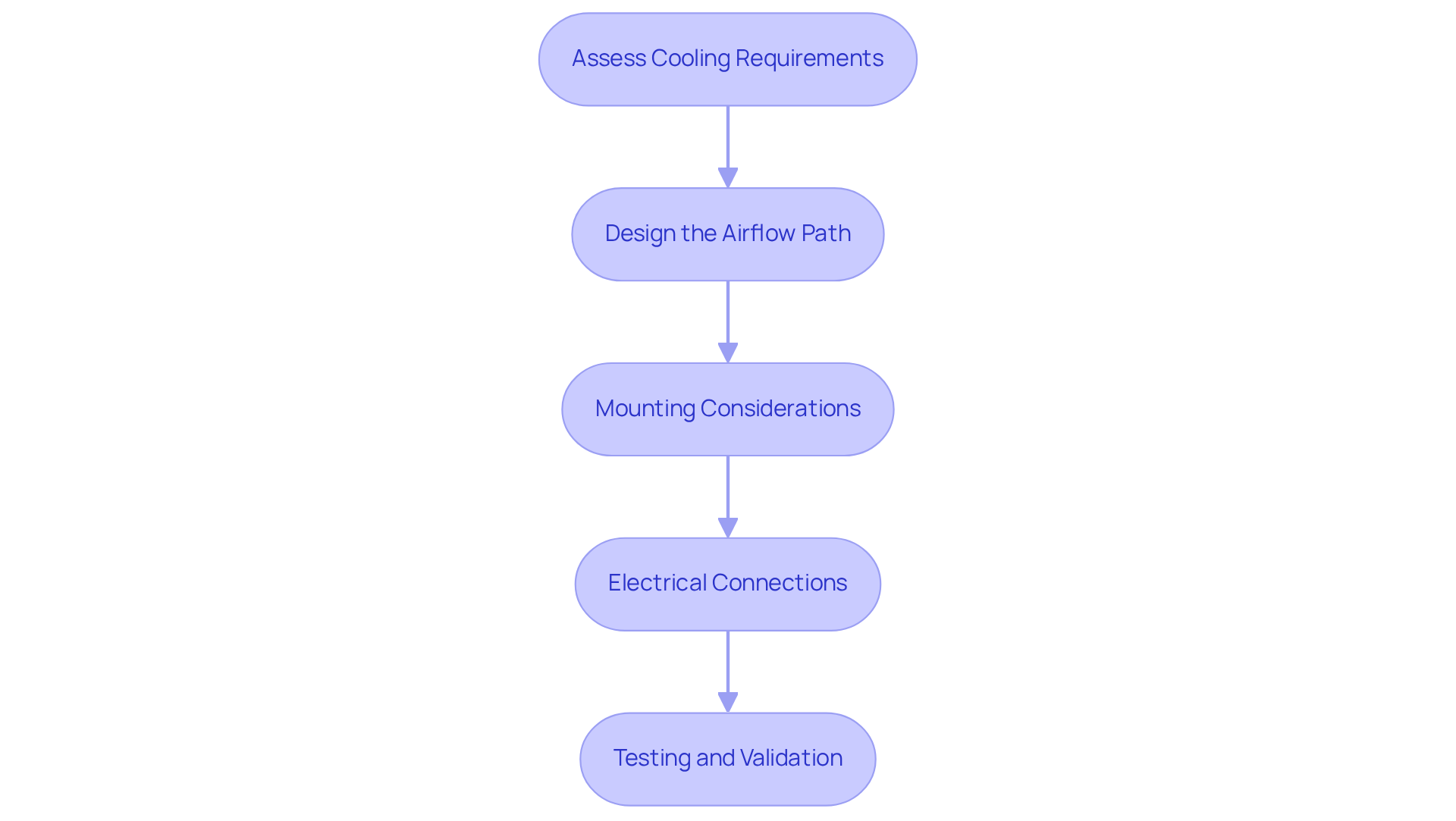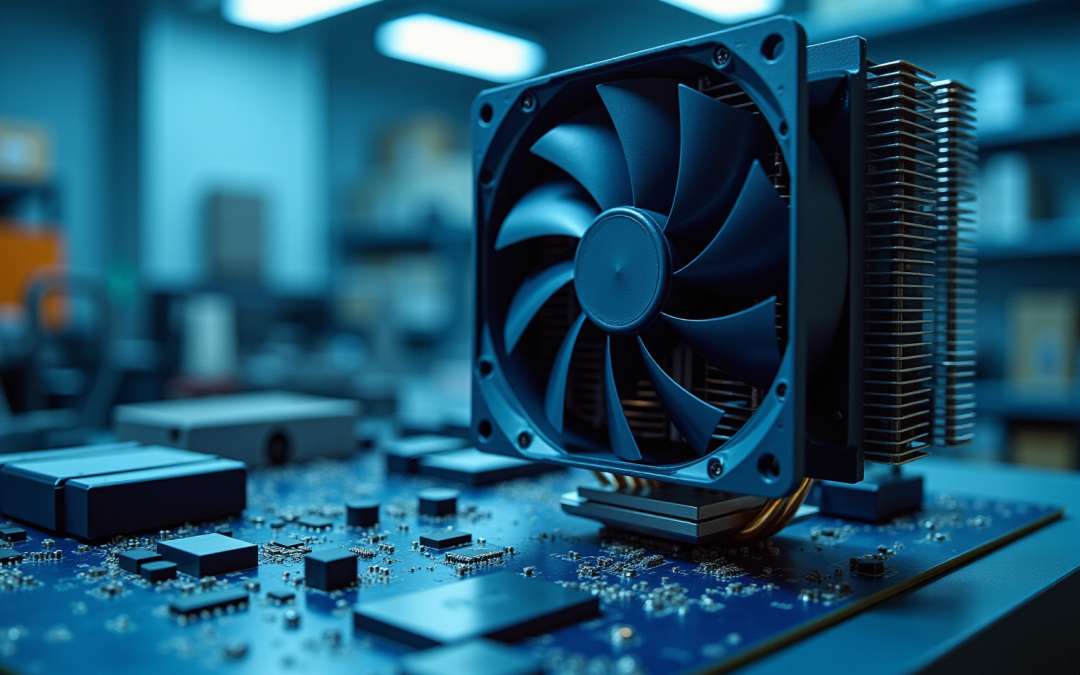Overview
The article centers on the applications and implementation of crossflow blowers, particularly for electronics engineers. It highlights their critical role in cooling electronic components, providing ventilation in compact spaces, and facilitating heat dissipation in power management systems. Key specifications necessary for selection—such as airflow rate and noise levels—are detailed to support informed decisions. Furthermore, the article outlines a systematic approach for integrating these blowers into electronic systems, aimed at enhancing performance and reliability. This comprehensive overview not only addresses the challenges faced by engineers but also offers actionable insights for effective implementation.
Introduction
The demand for efficient cooling solutions in electronic systems has reached a critical juncture, driven by the relentless miniaturization and increasing power of devices. Crossflow blowers emerge as a compelling option for engineers, distinguished by their unique ability to distribute air uniformly across surfaces, thereby enhancing performance and reliability. Yet, the challenge remains in comprehending their specific applications, technical specifications, and best practices for integration.
How can engineers effectively harness the advantages of crossflow blowers to optimize their designs and ensure optimal thermal management? This question invites a deeper exploration into the strategic implementation of these systems, paving the way for innovative solutions in thermal management.
Define Crossflow Blowers and Their Applications
Crossflow fans are specialized devices designed to move air across surfaces rather than in a linear direction. Their unique design promotes a wide airflow pattern, leading to efficient temperature regulation. Key applications include:
-
Cooling of Electronic Components: Crossflow blowers are extensively utilized to cool circuit boards and sensitive electronic components, ensuring optimal performance and extending their lifespan. Statistics indicate that these devices can enhance temperature regulation by as much as 30% compared to conventional fans, making them a preferred choice in high-performance electronics. Gagner-Toomey Associates, the globe’s largest producer of standard and custom air-movers, offers a variety of air-moving devices optimized for performance, efficiency, and low noise, addressing the growing demand for effective cooling solutions in the electronics sector. Their product line encompasses various sizes and types, ensuring compatibility with diverse applications.
-
Ventilation in Compact Spaces: With their slim design, airflow devices are ideal for confined areas where standard fans may not fit. This feature proves particularly advantageous in compact electronic systems, such as laptops and servers, where space is at a premium. An engineer noted, “The incorporation of lateral fans in our designs has enabled us to optimize cooling efficiency in limited areas, which is essential for sustaining performance.”
-
Heat Dissipation in Power Management Systems: These fans are crucial in maintaining temperature stability within power electronics, which is vital for reliability. Engineers have observed that integrating crossflow blowers can significantly reduce thermal accumulation, thereby enhancing the overall effectiveness of power management systems. Moreover, many models come with IP protection, ensuring durability and reliability in various environments.
By recognizing these applications, engineers can make informed decisions regarding the integration of lateral air movers into their designs, ultimately resulting in improved product performance and dependability.

Explore Technical Specifications and Operating Principles
When selecting a crossflow blower, engineers must consider several key specifications that are crucial for optimal performance:
- Airflow Rate: Measured in cubic feet per minute (CFM), this specification indicates the volume of air the blower can move. Gagner-Toomey offers a diverse range of DC input tube axial fans and centrifugal devices, with dimensions varying from 15 to 280mm. This variety ensures that engineers can access increased airflow rates necessary for cooling larger components.
- Static Pressure: This metric measures the crossflow blower’s capability to overcome resistance within the system. Understanding static pressure is vital for maintaining adequate airflow in restricted areas. Gagner-Toomey’s innovative designs are specifically tailored for performance and efficiency in such scenarios.
- Noise Levels: Recorded in decibels (dB), noise levels can significantly affect the usability of electronic devices, particularly in consumer applications. Gagner-Toomey’s products are engineered to operate with low noise, making them ideal for sensitive environments.
- Power Consumption: Efficiency is paramount in electronic systems; thus, selecting devices with lower power usage can lead to substantial energy savings. Gagner-Toomey’s extensive portfolio includes energy-efficient solutions that cater to a variety of applications.
Understanding these specifications enables engineers to select the appropriate crossflow blower for optimal performance and efficiency based on their needs.
The operating principle of these fans involves drawing air in from one side and expelling it across their width. This design allows for a more consistent airflow distribution, which is particularly beneficial in temperature regulation scenarios where uniform heat distribution is critical. Gagner-Toomey’s innovative temperature regulation solutions, including integrated custom temperature options, further enhance the effectiveness of airflow devices across diverse electronic applications.

Implement Crossflow Blowers in Electronic Systems
To successfully implement crossflow blowers in electronic systems, it is essential to follow a systematic approach:
-
Assess Cooling Requirements: Begin by determining the thermal load of the components requiring cooling. This assessment is crucial for selecting the appropriate fan based on airflow and pressure needs.
-
Design the Airflow Path: Strategically plan the layout of the electronic system to ensure that the airflow from the fan effectively reaches all critical components. It is important to avoid any obstructions that could impede airflow.
-
Mounting Considerations: Ensure that the fan is securely mounted and positioned to maximize airflow efficiency. Additionally, consider employing vibration dampening techniques to minimize noise and wear over time.
-
Electrical Connections: Adhere to manufacturer guidelines for electrical connections, ensuring that the fan is compatible with the system’s power supply.
-
Testing and Validation: After installation, conduct thorough thermal testing to validate that the cooling performance meets design specifications. Be prepared to adjust fan speed or positioning as necessary to enhance overall performance.
By meticulously following these implementation steps, engineers can effectively integrate crossflow blowers into their electronic systems, which significantly enhances both performance and reliability.

Conclusion
Crossflow blowers play a pivotal role in electronics engineering, providing an efficient solution for cooling and ventilation needs. Their unique design facilitates a broad airflow pattern, making them indispensable for maintaining optimal temperatures in sensitive electronic components, particularly in compact systems where space is limited.
The diverse applications of crossflow blowers are numerous, highlighting their effectiveness in:
- Cooling electronic components
- Ventilating confined spaces
- Ensuring reliable heat dissipation in power management systems
Critical technical specifications, such as airflow rate, static pressure, noise levels, and power consumption, underscore the importance of selecting the right blower for specific applications. This systematic approach to implementing these devices within electronic systems emphasizes the need for careful planning and execution to maximize performance and reliability.
In conclusion, the significance of crossflow blowers in electronics cannot be overstated. As technology advances, engineers must leverage these devices to enhance product performance and longevity. By understanding their applications and specifications, engineers can make informed decisions that lead to innovative designs and efficient cooling solutions. Embracing the potential of crossflow blowers is essential for driving progress in the ever-evolving field of electronics.
Frequently Asked Questions
What are crossflow blowers?
Crossflow blowers are specialized devices designed to move air across surfaces rather than in a linear direction, promoting a wide airflow pattern for efficient temperature regulation.
What are the main applications of crossflow blowers?
Key applications include cooling electronic components, ventilation in compact spaces, and heat dissipation in power management systems.
How do crossflow blowers benefit the cooling of electronic components?
They are extensively used to cool circuit boards and sensitive electronic components, enhancing temperature regulation by up to 30% compared to conventional fans, thus ensuring optimal performance and extending lifespan.
Why are crossflow blowers suitable for ventilation in compact spaces?
Their slim design makes them ideal for confined areas where standard fans may not fit, such as in laptops and servers, allowing for optimized cooling efficiency in limited spaces.
How do crossflow blowers contribute to heat dissipation in power management systems?
They help maintain temperature stability within power electronics, significantly reducing thermal accumulation and enhancing the overall effectiveness and reliability of power management systems.
What additional features do many models of crossflow blowers offer?
Many models come with IP protection, ensuring durability and reliability in various environments, making them suitable for diverse applications.

